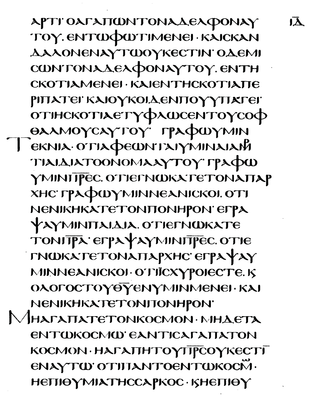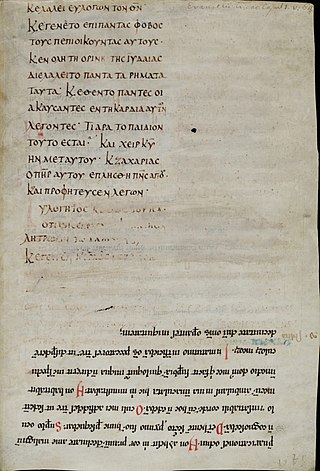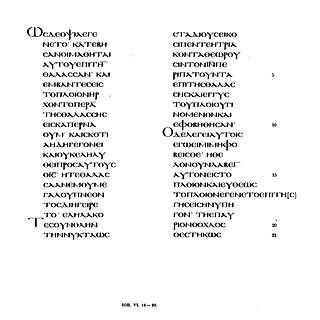Alfred Rahlfs was a German Biblical scholar. He was a member of the history of religions school. He is known for his edition of the Septuagint published in 1935.

Codex Petropolitanus Purpureus, designated by N or 022, ε 19, is a Greek New Testament codex containing the four Gospels. Using the study of comparative writing styles (palaeography), it has been assigned to the 6th century CE.

Codex Mutinensis designated by Ha or 014, α 6, is a Greek uncial manuscript of the Acts of Apostles, dated paleographically to the 9th century. The codex contains 43 parchment leaves.

Codex Porphyrianus designated by Papr or 025, α 3, is a Greek uncial manuscript of the Acts of Apostles, Pauline epistles, and General epistles, with some lacunae, dated paleographically to the 9th century. It is one of a few uncial manuscripts that include the Book of Revelation.

Codex Nitriensis, designated by R or 027, ε 22, is a 6th-century Greek New Testament codex containing the Gospel of Luke, in a fragmentary condition. It is a two column manuscript in majuscules, measuring 29.5 cm by 23.5 cm.
Uncial 054, ε 59 (Soden), also known as Codex Barberini, is a Greek uncial manuscript of the New Testament, dated paleographically to the 8th century.
Uncial 066, α 1000 (Soden), is a Greek uncial manuscript of the New Testament. Palaeographically it has been assigned to the 6th-century.
Uncial 068, ε 3 (Soden), is a Greek uncial manuscript of the New Testament, dated paleographically to the 5th century. Tischendorf designated it by Ib, Scrivener by Nb. It has some marginalia.
Uncial 078, ε 15 (Soden), is a Greek uncial manuscript of the New Testament, dated paleographically to the 6th century. It is a palimpsest.
Uncial 079, ε 16 (Soden), is a Greek uncial manuscript of the New Testament, dated paleographically to the 6th century.
Uncial 088, α 1021 (Soden), is a Greek uncial manuscript of the New Testament, dated paleographically to the 5th or 6th century.
Uncial 096, α 1004 (Soden), is a Greek uncial manuscript of the New Testament, dated paleographically to the 7th-century.

Uncial 097, α 1003 (Soden), is a Greek uncial manuscript of the New Testament, dated palaeographically to the 7th-century.
Codex Tischendorfianus I, designated as Uncial 0106, ε 40 (Soden), is a Greek uncial manuscript of the New Testament on parchment. It is dated palaeographically to the 7th century. The manuscript is fragmentary.

Uncial 0115, ε 57 (Soden); is a Greek uncial manuscript of the New Testament, dated paleographically to the 9th or 10th-century. Formerly it was labelled by Wa.

Uncial 0130, ε 80 (Soden), is a Greek uncial manuscript of the New Testament, dated palaeographically to the 9th-century. Formerly it was labelled by Wc.
Lectionary 135, designated by siglum ℓ135 is a Greek manuscript of the New Testament, on parchment leaves. Palaeographically it has been assigned to the 8th century.

Codex Marchalianus designated by siglum Q is a 6th-century Greek manuscript copy of the Greek version of the Hebrew Bible known as the Septuagint. The text was written on vellum in uncial letters. Palaeographically it has been assigned to the 6th century. Marginal annotations were later added to the copy of the Scripture text, the early ones being of importance for a study of the history of the Septuagint.

Lectionary 269, designated by siglum ℓ269 is a Greek manuscript of the New Testament, on parchment. Palaeographically it has been assigned to the 8th century. Scrivener labelled it as 175e, Gregory by 269e. It is a palimpsest, both the lower (older) and the upper (younger) text of palimpsest are the texts of New Testament lectionary. The manuscript has survived in a fragmentary condition.
Codex Turicensis is a 7th-century manuscript of the Psalter in Greek.










